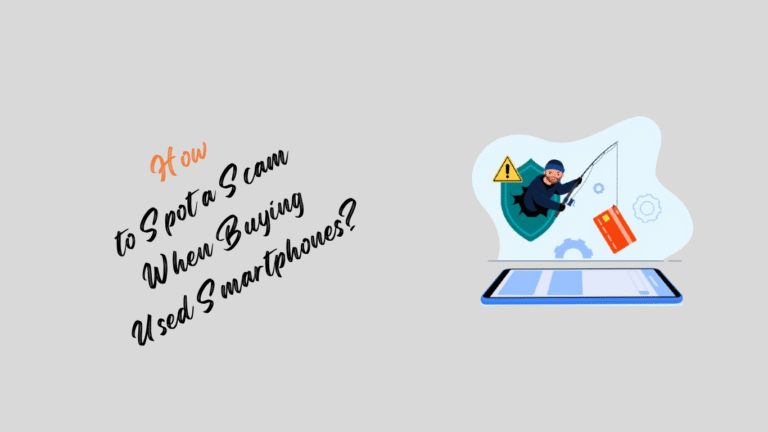Purchasing second-hand smartphones is a smart way to save money while still getting access to premium features. But with great deals come great risks. Scammers are constantly developing new ways to trick unsuspecting buyers. That’s why spotting smartphone scams has become an essential skill for anyone shopping in the second-hand tech market.
This guide will walk you through how to safely buy used smartphones and avoid getting ripped off, all while protecting your money and data.
Why Spotting Smartphone Scams Is So Important
The second-hand smartphone market is booming, especially on social platforms and local marketplaces. However, it’s also a hotspot for scammers who prey on buyers with limited tech knowledge. Falling for one of these scams could mean getting stuck with a stolen phone, a fake model, or a device that doesn’t even work.
That’s why spotting smartphone scams is more than just a precaution—it’s a necessity. Understanding common fraud tactics and red flags can help you make smart, secure purchases without falling into traps.
1) Research the Model and Market Value
Before committing to any deal, take the time to research the exact smartphone model you’re considering. Check current market values for used versions in similar condition and look for recurring complaints or issues with that specific model.
If a deal sounds too good to be true, it probably is. One of the key steps in spotting smartphone scams is knowing the typical price range. Unrealistic discounts are often used to lure buyers into rushed decisions.
2) Always Verify the IMEI Number
The IMEI number is like the fingerprint of a smartphone—it’s unique to each device. Scammers often sell stolen phones with blocked or blacklisted IMEIs. To verify a device’s status, simply dial *#06# or check under phone settings and enter the number on websites like IMEI.info.
This process is crucial for spotting smartphone scams, as it can instantly reveal if the phone has been reported lost, stolen, or tampered with.
3) Inspect and Test the Device Thoroughly
Never agree to buy a phone without testing it in person. Power it on, insert a SIM card, check call and text functionality, test both cameras, examine the screen for dead pixels, and ensure that all buttons and ports work as expected.
Many scams involve selling phones with hidden damage or issues like ghost touch or weak batteries. When spotting smartphone scams, your physical inspection is your best defense.
4) Only Buy from Trusted Sellers or Platforms
Online marketplaces like Swappa, Amazon Renewed, and even verified sellers on eBay offer buyer protection and seller accountability. Avoid making purchases from unverified individuals or sketchy online listings with little information.
Platforms that offer buyer protection make spotting smartphone scams easier by displaying seller ratings, reviews, and detailed product descriptions—allowing you to make informed decisions.
5) Request Original Packaging and Receipts
Genuine sellers usually have some proof of purchase or original accessories. Ask for the original invoice, box, and charger. If the seller claims they’ve lost everything, it could be a red flag—especially if they’re selling a high-value phone.
Including accessories and documentation shows ownership authenticity. Missing details or hesitations when providing these are common signs when spotting smartphone scams.
6) Avoid Suspicious Payment Methods
Never pay via wire transfers, cryptocurrency, or other untraceable methods. Instead, use secure payment platforms like PayPal or credit cards that offer fraud protection. Avoid sellers who insist on cash-only transactions.
One of the most effective techniques for spotting smartphone scams is being alert to pressure tactics involving fast, irreversible payments.
7) Meet in Public, Secure Locations
When buying locally, always meet in busy public places like coffee shops or police station parking lots. Bring a friend along and avoid evening or nighttime meetups. Scammers thrive on privacy and unpredictability.
Safe locations help in spotting smartphone scams, as scammers are less likely to show up when they know they’ll be on camera or among people.
Red Flags That Signal a Scam
Here are some clear warning signs you should never ignore:
- Seller avoids video calls or meeting in person
- IMEI check returns as blacklisted or unknown
- Price is drastically lower than usual
- Pressure to pay quickly or “reserve” the device
- The device comes without accessories or packaging
- The listing photos look too professional or are taken from other websites
Recognizing these signs is vital when spotting smartphone scams. The more aware you are, the safer your buying experience will be.
Final Thoughts
Buying second-hand smartphones can be a great way to save money—if done wisely. From verifying IMEI numbers and checking documentation to choosing safe payment methods, each step is essential in spotting smartphone scams effectively.
Stay informed, follow the tips above, and never rush into a deal. A little extra caution today can save you from a lot of regret tomorrow.
FAQs About Buying Second-hand Smartphones
What is the most important thing to check before buying a used phone?
The IMEI number. It reveals whether the phone is stolen, locked, or blacklisted. Always check this before handing over your money.
Can a phone be locked to an account even if it’s not blacklisted?
Yes, a phone can be locked to an Apple ID (iCloud) or Google Account (FRP lock). If the seller cannot unlock it, avoid the purchase.
Are there safe websites to buy second-hand smartphones?
Yes. Swappa, Amazon Renewed, and eBay (with top-rated sellers) are generally safe and provide some buyer protection features. Avoid random social media deals.
What should I do if I bought a phone and realized it’s a scam?
Report it immediately to the platform where you bought it and contact your bank or payment provider. If possible, file a police report and provide all details.
How can students protect themselves while buying used phones?
Students should stick to trusted platforms, verify IMEI numbers, meet in public spaces, and avoid cash deals. Educating themselves on spotting smartphone scams can prevent future losses.

